If water is fed to the house from the well, it requires cleaning. Sand, clay, iron, manganese, nitrates, bacteria, hydrogen sulfide - this is not a complete list of what can be contained in it. Depending on the degree of pollution, equipment is selected - sumps, aerators, filters. So that the water purification filters from the well are selected correctly, its chemical analysis is needed, and it is desirable deployed: it will be possible to more accurately choose the equipment for cleansing.
Cleaning steps
Cleaning water from the well passes in several stages:
- Preliminary cleansing. At this stage, coarse impurities raised from the well are removed from the water - sand, dissolved clay, other mechanical particles. This can be done in two ways: coarse filters or sumps. It is very undesirable to omit this stage: large particles quickly clog the filters of fine cleaning and even can break them.
- Removal of iron, magnesium and some other chemical impurities and gases.
- Softening is the removal of salts by the method of ion exchange, while the salts fall into the sediment and their residues are removed in the next stage.
- Thin cleaning and disinfection. At this stage, biological purification of microorganisms and bacteria occurs. And fine filters are sifted fine particles.
- Drinking preparation. At this stage, filters operating on the principle of reverse osmosis are usually put. Only the part of the fluid, which goes to cooking or drinking through them.
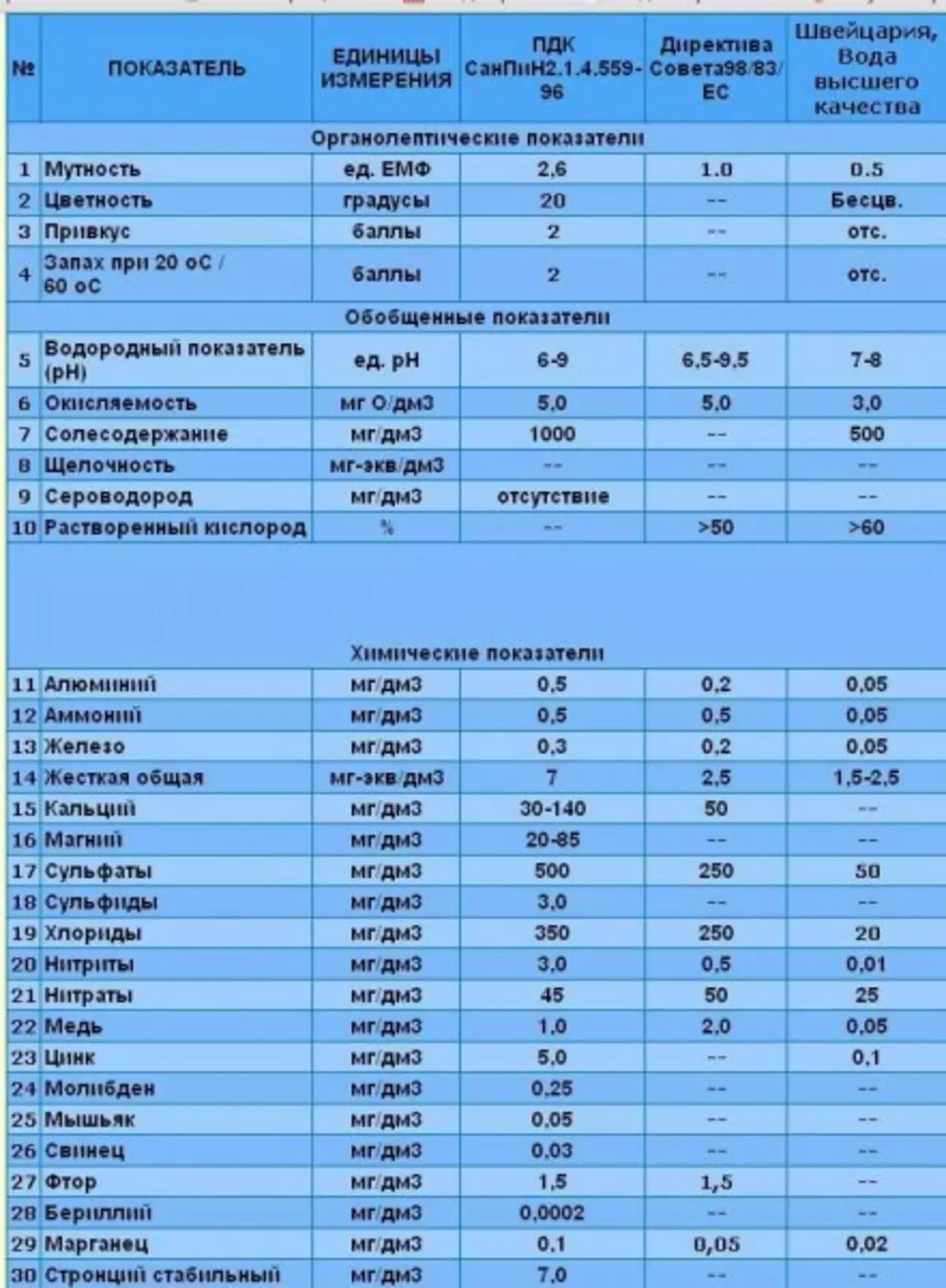
Different drinking water standards
In each case, the number of cleaning steps is determined based on the analysis of water from the well. If the content of any substances exceeds the norm, methods for reducing their concentration and equipment for this are selected.
About the system of autopolivation can be read here.
How to Clean Water from the Body from Sand
Removal of sand or clay particles, yla, other large particles occurs on the filter, lowered into the well. This is done using simple mechanical filters - lamellar or sandy and call this stage - a rough cleaning step.If there is a lot of suspension, you can not do with one filter: it will be quickly clogged. Practical to put a system with cells of different sizes. For example, water from the well falls on the filter by trapping particles up to 100 μm in size, then a filter is installed with a degree of cleaning up to 20 microns. They will remove almost all mechanical impurities.
Types of filters
Coarse filters are: mesh, cassette (cartridge) or falling ones. The mesh is most often put in the well. They are a hollow pipe slightly smaller diameter than the wellbore. In the walls of the pipe, the holes are drilled or the slit are done (the shape of the holes depends on the soil), the wire is wound from above, and the grid is. The grid cell is chosen depending on the type of soil of the aquifer: it must delay the bulk of pollution and at the same time not to clog. At this stage, the largest impurities are delayed, which can also damage the pump. But part of the solid particles still rises to the surface. They are removed in the process of further cleaning.
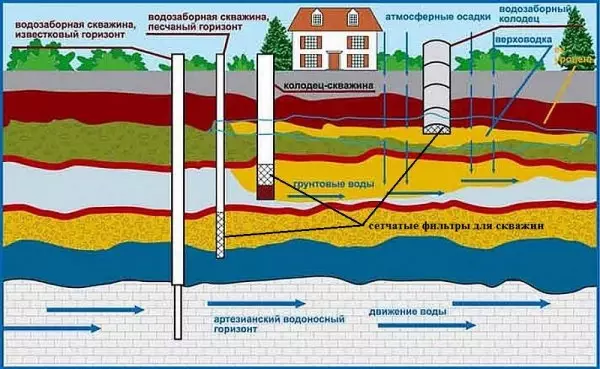
Mesh filters are installed in the well. They filter the sand and other coarse impurities
Sometimes put the filter in the well is not possible. Then all cleaning is transferred to the surface. For water purification from the well in this case, cassette or dumping filters are used. The cassette is a replaceable cartridge - a membrane system, crushed charcoal, and the like. which settles sand and other major pollution.
From time to time, cartridges are clogged and need to be changed. Periodicity depends on the degree of pollution of water and the intensity of its use. Sometimes one cartridge is quickly clogged. In this case, it makes sense to put two filters with different degrees of cleaning. For example, the first delays particles to 100 microns, and standing behind it up to 20 microns. So the water will be clean and cartridges will have to be changed less often.
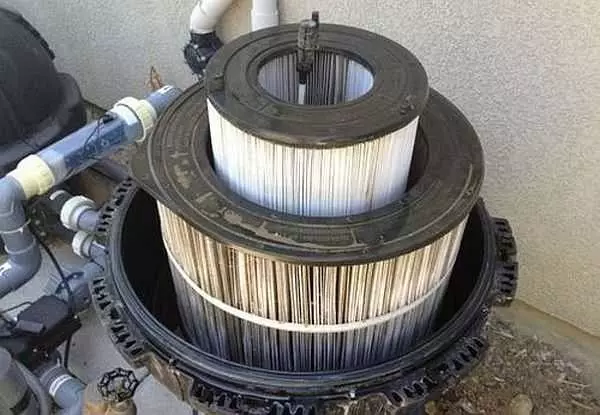
One of the types of water filtering cartridges in a private house
In flowing filters in the container, bulk filter material - sand, crushed shell, special filtrates (for example, BIRM (BIRM)) are poured into the container. The simplest mechanical filter is a sand bar having a flush function. One nuance: if there is a large amount of dissolved iron, it is preferable to fall asleep a special filtrate, it is also a catalyst that oxidizes the dissolved iron and manganese, forcing them to fall into the sediment.
Depending on the size of the frustration particles of such a filter, rather small particles can delay. Sometimes there are two such filters in a row, only with a different backfill - first, water falls into the one where the filtrate has large sizes, then with smaller filling. The bulk filters for water purification from the well are good in that they require replacement of backfills about every three years. And by this they differ from the lamellar, the filter of which must be changed much more often: sometimes once a month, sometimes - once in three or six.
But so that cleaning with a falling filter is effective, they need a periodic flushing of the filtrate. This usually occurs by overlapping alone cranes and opening others. In this case, water goes in another direction, leaning the main amount of accumulated precipitation.
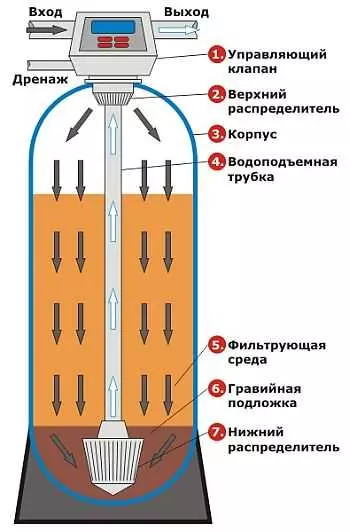
The principle of water purification in a falling filter
An example of the assembly of two consecutive filters for cleaning water from coarse impurities See in the video.
How to make a venture for cleansing a well can be read here.
How to Clean Water from Iron Well
The most common problem with water raised from wells is an exceeded iron content. If we talk about sanitary standards, then the permissible iron level in water is 0.3 mg / l. If the concentration increases, a specific taste appears. When iron content, more than 1 mg / l varies already color - after a short settling, a characteristic reddish - rusty - shade appears.Of reliable data on the occurrence of pathology or the development of any diseases in the use of water with an increased amount of iron is not, but drinks and food have far from the most attractive look and taste. But such water can help with a reduced hemoglobin in the blood, if you will drink it enough. However, water from iron is more often cleaned, and, at least, to sanitary standards. The reason - iron is deposited on household appliances, which often becomes caused by its failure. There are several types of equipment to remove iron from water.
Reverse osmosis
This is perhaps the most efficient way: almost all particles are removed. In this water purification equipment, there are special membranes that skip only H2O molecules. All other are settled on the filter. A special cleaning system allows you to automatically remove accumulated contaminants that are discharged into the sewer or drain pit.
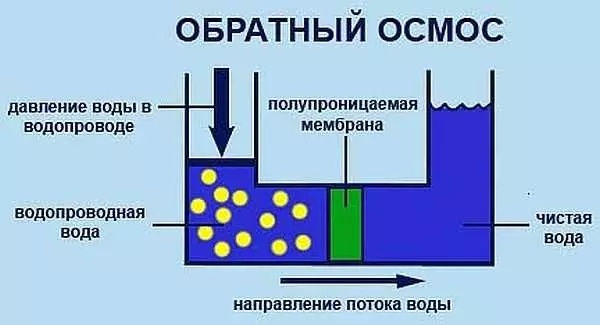
The principle of operation of the reverse osmosis system: cleans water special membrane
Reverse osmosis removes not only iron, but all other substances dissolved in water. The problem is insoluble particles, including sand and trivalent iron (rust): they score filters. If you have a large number of these impurities, there are coarse filters (described above) before equipment inverse osmosis. Another nuance: This equipment is installed on the water pipe and operates under certain pressure.
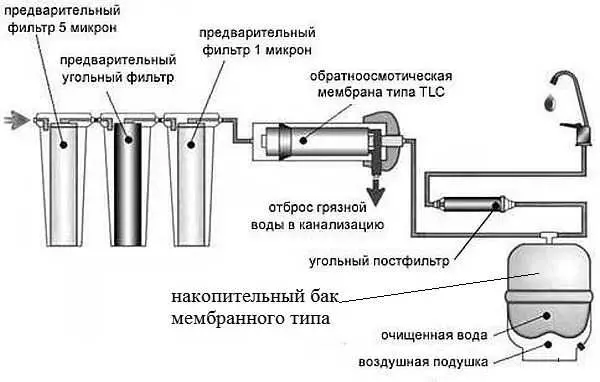
An example of a well purification system from a well with pre-cleaning filters and a osmosis system to prepare drinking water. The membrane tank is needed to create a constant pressure in the system.
Nevertheless, the main disadvantage of such a system is its high cost, and the filters are also silent, and they need to change them about the same periodicity as in cartridge installations (once in one or three months). Because most often this equipment is put to prepare drinking water - installed under the sink, remove a separate crane and use only drinking or cooking. To purify the rest of the water - for technical needs - use other methods and methods.
Filters for water purification from well with ion exchange resins
On the device, they are very similar to cartridges, but there are special filters with resins in them, which iron replaced with sodium. At the same time, water softening occurs: magnesium and potassium ions are also associated. This equipment has several types of devices. For small volumes, cartridge filters are suitable, for large, they are not enough and filter columns are installed, which can provide clean water at a considerable flow rate. That is why, when selecting filters and equipment for cleaning water from the well, still medium and peak consumption: to choose the right performance.
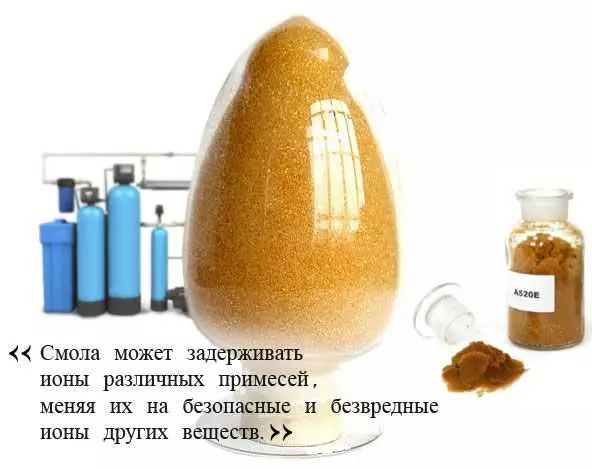
Ion exchange resins replace harmful substances for neutral
Removing iron from water aeration
Filters for water purification from well are effective, but not cheap equipment. It is possible to solve the problem easier: with aeration. The fact is that iron is present in the water in two forms: a dissolved bivalent shape and falling into the sediment is trivalent. The principle of aeration is based on the addition of oxygen into water, which oxidizes a bivalent iron dissolved in water to trivalent, which falls into a precipitate in the form of a rusty precipitate. In addition to rust, this method neutralizes the manganese, hydrogen sulfide (gives the smell of rotten eggs), ammonia.Pressure systems aeration
On the device, aerators can be divided into non-per-on and operating under pressure. The pressure aerator consists of a aeration column and a compressor that pumps air. In the upper part of the column there is an automatic trigger valve that removes the surplus air. Water can fall into it, so it is connected to the sewage system.
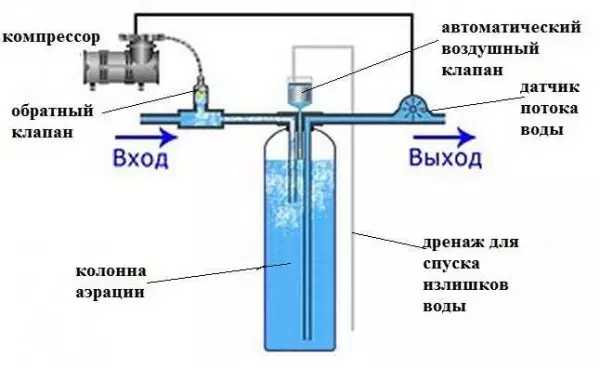
The method of purification of water from iron with the help of pressure aeration
Water is closed from the bottom third of the aeration column, but not too low, since an insoluble precipitate accumulates on the bottom - the result of purification. The system is included only in the presence of water consumption. For this, the output is the flow sensor. As soon as the crane was discovered, the compressor is turned on, closed, it turned off.
Pressure aeration system is also not the cheapest pleasure. But it is necessary if the content of iron or other solutes is exceeded at 30 or more times. Otherwise, you can not get rid of such a number of pollution: the filters will be litior very quickly.
Non-free water treatment systems
The second type of aeration system is non-pressure. It has a large container in which water is defended. The capacity of the container is from 600 liters, but at all it depends on the water consumption: there should be no more than 50-60% of the existing volume so that the sediment remains at the bottom.
Water in the container is served immediately from the well. The water level can be controlled by the sensors - the bottom and top level or, as in the photo, the float switch of the borehole pump. To protect the system from overflowing just above the critical level, the water discharge nozzle is made. It can go to a drainage or sewer system. It is important that there are any visual sensors that water in the tank has typed too much.
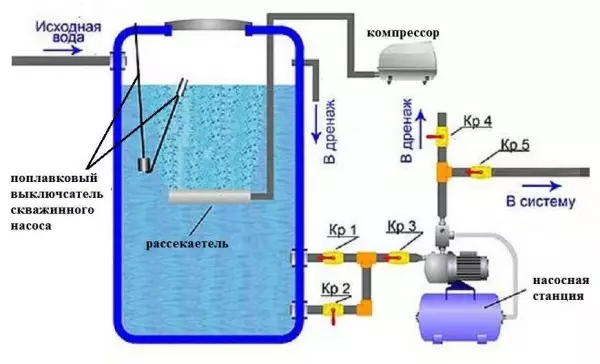
Non-free aeration system for cleansing water from a well from iron, manganese, other impurities and dissolved gases
Such a system works like this: to the required level in the tank, water is gained, after which the pump is turned off. To purify the water, the compressor is turned on (can be powerful for aquariums), which supplies air to the tank. It is distributed through a divider, which is about half of the depth.
To ensure permanent pressure in the system, water from the container can be retracted using a pumping station. The water welding occurs from the bottom third, but not from the bottom (through the crane 1): the cleanest water accumulates here. It enters the pumping station through the crane 3 and from there through a tee and crane 5 goes to the system.
The scheme above also provides a cleaning system. In this case, the crane 2 and crane 5 is closed, the crane 2 and the crane 4. Sediment from the bottom with this position of the locking elements are merged into the sewer or drainage system. After the precipitates were removed, you need to lower some quantity of clean water to rinse well all pipes. Only when clean water goes into the sewer, all cranes can be returned to its original position.
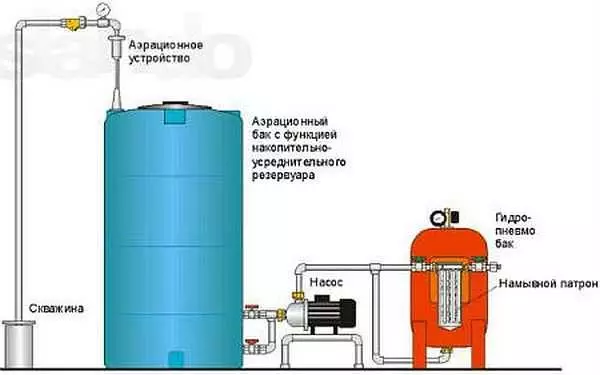
Another way to organize water purification from well
You can read about the systems of drip irrigation here.
Water purification systems from well with their own hands
One of the options for homemade water purification from the well using the aeration method is demonstrated in the photo below. There are two aeration steps for more complete water purification and removal of all impurities. The need for a second stage is determined based on the results of cleaning the first stage: not always the quality is satisfactory. Repeated aeration can help in this, but this is not the only way out: you can put one of the filters. It will cope well with the task, and will rarely be clogged.Two-stage water purification system from well
In this embodiment, water from the well is supplied through the heaters for the shower. Thus, the primary oxygen enrichment occurs. There is also a immersed sprayer from aquarium compressor. The water level is controlled by a float switch (used to control water in the pool). In the lower part of the tank there is a tap for the drain of the outstanding substances.
From the first capacity, water welding occurs as in the previous version, from the bottom third. The system is organized in the same way. From there, water can be fed to the filter of the finish cleaning and disinfection, and then divorces the house.
Another example of a homemade water purification system from the well, look in the video.
Self-cleaned tips for water purification
If we talk about homemade systems, cleaning water from the well, then often use different approaches and methods. Here are some quotes:
I remove iron cheap and simple. I have a 120 liter tank. I smell 7-10 grams of lime into it, then 4-5 hours I blow up the compressor from the aquarium and give 3 o'clock. Then water feeds to the filter with a cartridge on 2 microns, and from there already in the system. This method made in the country. I change the filter once a month. A friend at home made a system more - by 500 liters. There are two compressors for 12 hours. If you increase their power, time can be reduced.
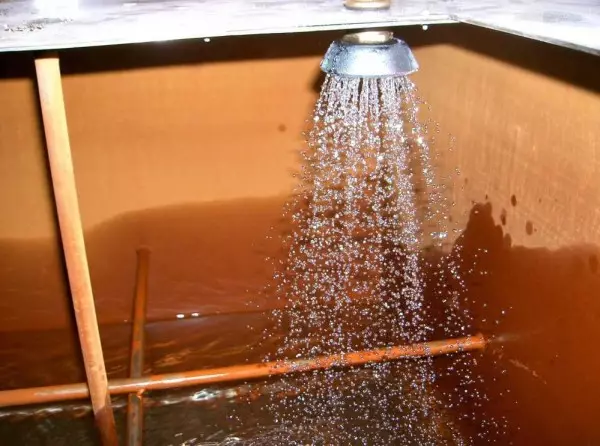
This looks like the primary enrichment of water with oxygen in the homemade version: Watering of the soul, through which water flows. Only to raise it is preferably higher, so that oxygen is more captured
The second option is no less interesting:
I walked from the well a lot of sand and il: I have a lot of consumption and "pulls" a lot of all rubbish. I solved the installation of the filter. Only the native cassette stoles (after the filter became unsuitable), and embanked crushed shells into it. Some pour marble crumb. It works fine too. Only the fraction is not needed small, but it will be quickly clogged. And then I have a tank with blowing (aeration), and after it is already a filter that removes the fact that the first two could not. Last filter I have a beam with a frighting barm. It has a crane for washing. So once in a couple of weeks I am a backfill, and you need to change it in three years.
Article on the topic: Wallpaper for the toilet in the apartment: 35 photos of the interior
